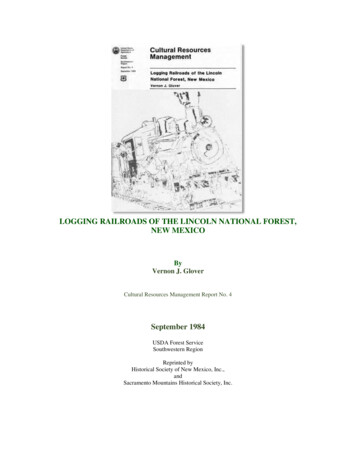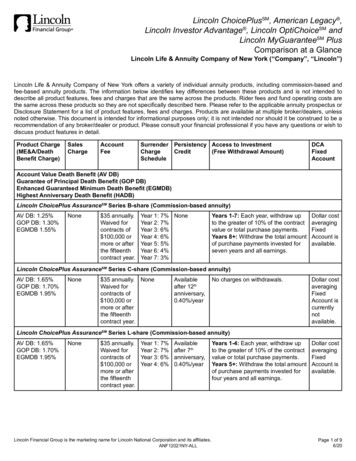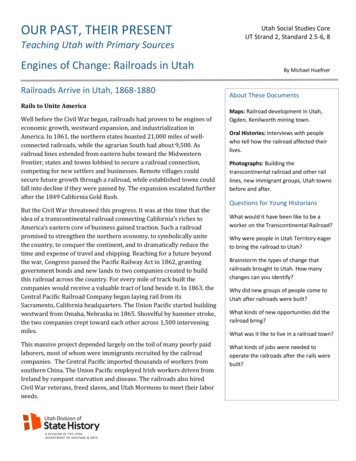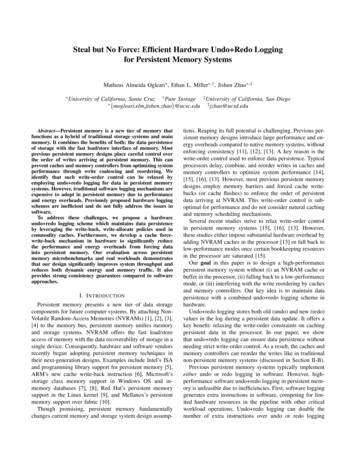
Transcription
LOGGING RAILROADS OF THE LINCOLN NATIONAL FOREST,NEW MEXICOByVernon J. GloverCultural Resources Management Report No. 4September 1984USDA Forest ServiceSouthwestern RegionReprinted byHistorical Society of New Mexico, Inc.,andSacramento Mountains Historical Society, Inc.
TABLE OF CONTENTSFIGURESTABLESPUBLISHER'S NOTEACKNOWLEDGEMENTSHISTORIC OVERVIEWIntroductionThe Main LineAlamogordo and Sacramento Mountain RailwayTHE LOGGING COMPANIESAlamogordo Lumber CompanySacramento Mountain Lumber CompanySouthwest Lumber CompanyCloudcroft Lumbar and Land CompanyGeorge E. Breece Lumber CompanyEpilogueLOGGING RAILROAD TECHNOLOGYThe Nature of Logging RailroadsCivil EngineeringFacilitiesShays, Heislers and Rod LokeysLocomotive RostersCONCLUSIONAPPENDIXREFERENCES CITED
LIST OF FIGURES1. An interesting early view showing most of the railroad between Toboggan and Cloudcroft2. The steepest part of the A&SM was the last five miles to Cloudcroft3. SP 2507 charging up the grade at Bailey's with a string of empty log cars, ca. 19364. A train of empties passing over the "S" trestle, ca. 19365. The Cloudcroft Lodge was rebuilt as seen here in 1910-19116. Engineer F. M. Weldy was killed when locomotive 184 ran away7. The last scheduled train stopped briefly at Wooten tank, September 12, 19478. Railroads in the vicinity of Cloudcroft9. Water tank and engine house in James Canyon, ca. 1900-190210. Alamogordo Lumber company steam log loader at work ca. 189911. Alamogordo Lumber Company Shay geared locomotive and train loading logs12. Alamogordo Lumber Company logging camp, probably in Russia Canyon, April 21, 190713. The A&SM ended at Russia Canyon14. Sacramento Mountain Lumber Co. camp at Hudman's, 1.8 miles north of Russia15. Sacramento Mountain Lumber Co. railroad through Douglas fir cutting on Benson Ridge16. Sacramento Mountain Lumber Co. logging railroads south of Russia17. Louis Carr, owner of Southwest Lumber Company and Lincoln N.F. Supervisor Arthur18. Southwest Lumber Company railroads around Penasco Canyon show sidehill construction19. Logging crew with horses going into the woods from Water Canyon20. Caterpillar tractor and hydraulic arch hauling logs21. Skidding logs to railroad landing with Caterpillar tractor
22. The SWLCo extension south of Penasco Canyon used a series of switchbacks23. The SWLCo railroad climbed out of Wills Canyon24. Aerial photo of Hay Canyon switchbacks25. Southwest Lumber Co. yards at Alamogordo26. Lumberyard and sawmill of Penasco Lumber Co., four miles south of Russia27. Log train passing the wye track in Cloudcroft28. Logging camp at confluence of Brown and Cathey Canyons29. George E. Breece Lumber Co. sawmill and Texas-Louisiana Power Company steam powerplant30. Skidding logs with hydraulic arch and Caterpillar tractor31. Log landing and cut over slope on Mescalero Apache Reservation32. George E. Breece Lumber Co. loader working at landing on Mescalero Apache Reservation33. Cooper's logging camp in Silver Spring Canyon, Mescalero Apache Reservation34. Alamogordo & Sacramento Mountain Railroad S—curves to gain elevation below HighRolls35. Typical rail section36. Typical turnout design37. Detail of Mexican Canyon trestle, ca. 193638. Log train on the "S" trestle below Cloudcroft, ca. 191039. Alamogordo & Sacramento Mountain Railway locomotive in its original wood burningcondition40. Shay patent geared locomotive, number 105, pulled a 334-ton train of 41 empty log cars41. Southwest Lumber Company log train near Russia hauled by Shay locomotive number42. Southwest Lumber Company loading logs in Water Canyon43. George E. Breece Lumber Co. log train leaving Landing
44. Loads of twenty foot logs on the Alamogordo & Sacramento Mountain Railway45. Dedication Day of the A&SM, celebrated at Toboggan on November 16, 189846. An excursion train ready to leave Cloudcroft, ca. 190947. A down-bound EP&SW mixed train on the Mexican Canyon trestle below Cloudcroft48. SP 2506 standing on the "S" trestle below Cloudcroft, ca. 193649. Locomotive SP 2507 pulling upgrade at Bailey's Canyon ca. 193650. Picking up logs at chute terminal in Hubbell Canyon on Southwest Lumber Companyrailroad51. Unloading logs at Southwest Lumber Co. mill pond at Alamogordo52. Log chute or skidway in action, with boy "greasing the skids."53. Log skidway along Southwest Lumber Co. railroad in Hubbell Canyon54. Mule team skidding logs in winter on the Alamogordo Lumber Company55. SP 2510, derailed as a result of a broken lead truck axleLIST OF TABLES1. Standard Rail Weights and Dimensions2. Locomotives of the Alamogordo & Sacramento Mountain Railway3. El Paso & Northeastern Railroad; El Paso & Southwestern Railroad Southern PacificCompany4. Logging Locomotives of the Alamogordo Lumber Company, 1898-1916: SacramentoMountain Lumber Company, 1916-1920: and Southwest Lumber Company, 1920-19455. Logging Locomotives of the Cloudcroft Lumber and Land Company, 1924-1926 and GeorgeE. Breece Lumber Company, 1926-1940
PUBLISHER'S NOTELOGGING RAILROADS OF THE LINCOLN NATIONAL FOREST, NEW MEXICOByVernon J. GloverThis volume represents the second printing of this work originally published by the ForestService of the United States Department of Agriculture. This work is being reprinted withpermission of the Forest Service and the author. This printing is being co-sponsored by theHistorical Society of New Mexico, Inc., and the Sacramento Mountains Historical Society, Inc.The net proceeds of the sale of this publication will benefit the respective historical societies.You may purchase additional copies of this book through the Historical Society of New Mexicoat P. O. Box 36052, Station D, Albuquerque, New Mexico 87176 for 8.50 plus 1.50 postageand handling (total 10.00).The Historical Society of New Mexico was founded in 1859 and has continued to work for thepreservation of New Mexico history. You are welcome to join the Historical Society of NewMexico by writing to its address at P. O. Box 5819, Santa Fe, New Mexico 87502. The HistoricalSociety of New Mexico has also been instrumental in the preservation of New Mexico's historicoperating railroad known as the Cumbres & Toltec Scenic Railroad. You are welcome to join themuseum group supporting the preservation of the Cumbres & Toltec by writing to the Friends ofthe Cumbres & Toltec Scenic Railroad, P. O. Box 222, Chama, New Mexico 87520.The Sacramento Mountains Historical Society was founded in 1977 and supports thepreservation of the local history of the Lincoln Forest and the Sacramento Mountains in southernNew Mexico. A beautiful display and museum, including a large railroad collection relating tothe Alamogordo & Sacramento Mountain Railroad, is open to the public in Cloudcroft, NewMexico. You are welcome to join the Sacramento Mountains Historical Society by writing to itsaddress at P. O. Box 435, Cloudcroft, New Mexico 88317.June 1989
ACKNOWLEDGMENTSMany people provided the essential raw materials for this report in the form of information,articles from scattered sources, and photographs. Kramer Adams tabulated logging companystatistics from "The Timberman". Henry E. Bender, Jr., provided much early support andlocomotive information. Walter Casler provided Heisler locomotive information from originalsources. Joseph P. Hereford, Jr., found important information in many diverse sources andoffered it freely. John T. Labbe provided logging data. Bill Lock made numerous observationsand found interesting information. Dorothy J. Neal provided a wealth of photographs as well asthe results of her own research. P. E. Percy, of the Baldwin-Lima-Hamilton Corporation,provided Shay locomotive data and photographs from the builder's files. Dan Ranger shared hisShay locomotive research. Olaf Rasmussen walked the old rail beds and provided theinformation for the maps. Doug Richter, Joe Strapac, and Bert Ward contributed much of thelocomotive roster data. Arthur Olives and Dick Rudisill of the Museum of New Mexico PhotoArchives aided in searching out photographs and information. The Forest History Societyprovided an inventory of Forest Service photographs, which is the foundation of our knowledgeof the photographs in this report.
HISTORIC OVERVIEWIntroductionThe age of the steam logging railroad in the Sacramento Mountains was very brief by mostmeasures, barely over forty years. During that period, however, the railroads brought about manychanges affecting the land and our view of it. For the first time, extensive mechanized loggingtook place over a large area. During the same period, the tourist and resort business wasdeveloped and vigorously promoted. The tourists came by the thousands, first by rail, then byroad. The district's economy was transformed from one of frontier farming and ranching to onewith a capital-intensive industrial base closely tied to regional and national trends. The evolutionof the lumber industry left its own mark on the mountains in the form of rail beds, skidways, andcampsites. Decades after their abandonment, these signs of human activity are, for the most part,forgotten and unknown to most of the present users of the National Forest.The purpose of this study, which was requested by the Southwestern Region of the U.S. ForestService, is to provide a description and history of the railroad logging industry that so profoundlyaffected the Sacramento Mountains. In addition, a general interpretation of the artifacts of thesteam logging railroads is provided to aid those responsible for subsequent studies and surveys ofthe cultural resources within the Lincoln National Forest (see frontispiece for area map).A large part of the construction of railroad lines into the area predates the formation of theNational Forest. Information and records are scattered among numerous institutions andindividuals. Gathering together the bits of data has been a labor of love on the part of severaldedicated people rather than a project to be completed to a timetable. Nevertheless, the materialpresented here is a reasonably comprehensive picture of the business and engineering history ofthe logging railroads.The history of the early lumbering industry in the Sacramento Mountains is inextricably involvedwith that of the main line railroads of southern New Mexico and west Texas, especially thecompanies that make up the Southern Pacific lines. The key element of the relationship was thetimber itself. Railroad construction required immense quantities of timber for crossties, trestles,buildings and structures such as culverts, water tanks and cooling chutes. The ongoingmaintenance and upkeep of these facilities required significant quantities of timber on acontinuing basis. In addition to the railroads, mining companies in the region used timberextensively for underground supports and for material-handling structures both above and belowthe surface. The mining market was very competitive and the miners' requirements were oftenfilled by timber shipped in from as far away as Oregon. This added considerably to the risk ofthe lumber and timber trade in the southwest.In the days of railroad expansion in the southwest it was the practice of the men building therailroads to become involved in mining and other related enterprises to provide some traffic forthe railroads. Often, too, mining men would build railroads to gain access to their markets and toreduce their shipping costs. All of these relationships, reflecting regional and even nationalconditions, had considerable influence over the day-to-day affairs of otherwise locally managed
enterprises. This was certainly true of the logging companies in the Sacramento Mountains (Neal1966:1).Location maps showing the Alamogordo vicinity and units of the Lincoln National Forest.
A schematic representation of the total railsystem in the Lincoln National Forest's SacramentoMountains.The Main LinePlans to build a railroad to the Sacramento Mountains began almost with the arrival of the SantaFe and the Southern Pacific main lines in El Paso, Texas, during the first half of 1861. A linecalled the El Paso and White Oaks Railroad was incorporated in New Mexico on February 28,1882 (N. M. Corp. Commission n.d.). Little came of this enterprise and it was not until June1888 that a more substantial attempt was made with the incorporation of the Kansas City, ElPaso and Mexican Railroad (KCEP&M) (Engineering News 1869).By December 1, the KCEP&N had completed ten miles of track, extending northward to a pointcalled Lanoria, Texas, from a terminal in El Paso. Once more, interest in the project lagged, andconstruction trailed to a halt. Morris R. Locke, who was promoting the line, noted in hisprospectus the potential value of the timber traffic to be drawn from the Sacramentos. It wasimportant, but it was considered to be only a fraction of the revenues to be gained throughdevelopment of the coal and metal mines near White Oaks (Engineering News 1889).
It was not until 1896 that the ultimately successful El Paso and Northeastern Railroad (EP&NE)appeared on the scene. The first incorporated entity was the El Paso and Northeastern RailroadCompany, incorporated in Texas on June 12, 1896. Its stated purpose was to build 19.22 miles ofrailroad from El Paso to the New Mexico boundary (Poor 1902:493). This corporation was set upto comply with the Texas law requiring that all railroads operating in the state be headquarteredin Texas.Next to be incorporated was the New Mexico Railway and Coal Company (NMRy& CCo), inNew Jersey on May 15, 1897. This was the overall holding company, controlling not only therailroads but the lumber and mining companies as well. And on October 21, 1897, the El Pasoand Northeastern Railway was incorporated in New Mexico for the purpose of building arailroad from the Texas line to the Capitan coal fields (Poor 1902:493).The promoter of the EP&NE lines was Charles Bishop Eddy, who had earlier developed thecommunities along the Pecos River in southeastern New Mexico. For the EP&NE venture, heobtained the very substantial backing of a group of capitalists from Scranton and Wilkes-Barre,Pennsylvania: H. M. Boies, Benjamin S. Harmon, John Welles Hollenback, F. L. Peck, CharlesO. Simpson, and others (Poor 1902: 493). These men acted in various roles in the increasinglycomplex structure of the NMRy&CCo. Before long numerous subsidiaries would be involved inbranch line railroads, a new main line railroad, coal mining, and lumbering activities.Construction of the EP&NE began in December 1897, working out of El Paso. Some 4.16 milesof the old KCEP&N route were used, then the line ran northeast directly toward the SacramentoMountains. By June 15, 1898, the tracks had reached the site of the new town of Alamogordo.Located near a good spring at the foot of the mountains, the point was 86 miles from El Paso.Alamogordo was selected as the site of the main shops of the new railroad. It had the necessarywater, it was near the junction of the planned logging railroad, and the land was under the controlof the EP&NE backers (Neal 1966:5).The EP&NE construction forces paused only briefly at Alamogordo. Within a matter of weeks,work had begun on the new logging road, the Alamogordo & Sacramento Mountain Railway,into the mountains. Within a few months work resumed on the main line toward Carrizozo andthe coal mines near Capitan. The main line tracks reached Three Rivers on June 20, 1899, andCapitan on August 3. At Carrizozo the tracks swung eastward and began climbing toward IndianDivide, a pass between the White Mountains and the Vera Cruz Mountains. This came as asurprise to some who had assumed that the railroad was inevitably headed for the mining town ofWhite Oaks. But the goal of the railroad was in fact its own coal mines, located on Seaborn T.Gray's ranch, just to the north of the future site of Capitan. The tracks reached the mines onOctober 1, 1899, and coal production began immediately (Myrick 1970:76).It was not long until the limitations of the Capitan mines became painfully apparent. Cut andbroken by volcanic intrusions and slate, the coal veins could not be efficiently worked to producethe amount of coal needed for the railroad and other customers. Eddy and his attorney, WilliamAshton Hawkins, were very much aware of the disaster facing their young enterprise, and acomplex and somewhat bewildering series of events began to unfold. Eddy and Hawkins securedan option on the excellent coal under Dawson's ranch up on the Maxwell Grant in northern New
Mexico (Keleher 1962:291-293). Then the Chicago, Rock Island and Pacific Railroad resumedconstruction of a long idle line extending west and south from Liberal, Kansas. For its part, theEP&NE commenced building an extension northward from Carrizozo under the name El Paso &Rock Island Railway. From a start on January 15, 1901, this line met the Rock Island at SantaRosa, New Mexico, on February 1, 1902. This connection completed a through main line toKansas City and St. Louis, opening those markets to the timber trade (Myrick 1970:76-77).The EP&NE construction gangs didn't stop at Santa Rosa. They moved up to the raw new townof Tucumcari and built the Dawson Railway northward to the mines at Dawson's ranch. To speedthe opening of the mines, a second railhead was established through a connection with the SantaFe Railway at French, New Mexico. The first coal shipment went out over this spur on May 23,1902. The entire Dawson line was opened for traffic on July 1, 1903. With the completion of theDawson Railway, the expansion of the NMRy&CCo was completed (Myrick 1970:82).During the same period, the copper interests of Phelps Dodge & Company had pushed their ElPaso and Southwestern Railway (EP&SW) from Bisbee, Arizona, across southwestern NewMexico to EL Paso, completing the line on November 19, 1902. The EP&SW not only connectedthe mines at Bisbee with the new smelter at Douglas, Arizona, but it provided connections to anumber of other railroads to avoid dependence on one hauler. Given their need for coal andtimber, as well as an interest in competitive transportation it was not surprising when, on July 1,1905, Phelps Dodge purchased the entire property of the NMRy&CCo. The railroad properties,including the mountain branch, were immediately merged with the EP&SW for operation undera single management (Myrick 1970:88-89).Although the EP&SW was a financial success, it was essentially an industrial feeder linedependent on its connections with the Southern Pacific and the Rock Island for profitablethrough traffic. Ultimately, Phelps Dodge decided to concentrate on copper production, and soldits interest in the EP&SW to the Southern Pacific (SP) on November 1, 1924. This ownershipcontinued throughout the remaining life of railroad logging in the Sacramento Mountains(Myrick 1970:94).Alamogordo and Sacramento Mountain RailwayAs the EP&NE neared Almagordo, its backers went to work to develop a timber industry in thenearby Sacramento Mountains. The Alamogordo Lumber Company was organized to purchaseland, build a sawmill, and log in the mountains. The connecting link was to be the Alamogordoand Sacramento Mountain Railway (A&SM), incorporated in New Mexico on March 24, 1898.In the coming years, the A&SM would be the longest portion of the route traversed by logs ontheir way to the sawmills (Neal 1966:10).Construction of the A&SM began in mid-1898, shortly after the main line arrived inAlamogordo. The first section of the A&SM was opened during November 1898. It extendedfrom Alamogordo Junction (1.4 miles north of the Alamogordo depot) to a point in upper FresnalCanyon called Toboggan, 19.3 miles from the junction. The engineering of the route was aclassic example of mountain railroad design. To make the climb from Alamogordo Junction at4,372 feet elevation to Toboggan at 7,580 feet, the railroad was a nearly continuous series of
sharp curves combined with steep grades. The normal curvature was a so-called 30 degree, or193 foot radius, bend. Grades exceeded five percent, with one half-mile stretch of over sixpercent peaking at a fearsome six and one-half percent. The result was a standard gauge railroadthat far exceeded the fabled Colorado narrow gauge roads in severity (Railroad Gazette1902:466).Such a railroad offered plenty of spectacular views to its passengers as it wound along the ridges.That proved to be one of its assets. The steep and sinuous track presented plenty of problems,too. Locomotives had to be specially designed and equipped to operate on the line. Brakes had tobe efficient and well kept. Ultimately, log cars with dual brake systems became the norm. Wetand icy weather proved to be a regular and occasionally fatal hazard. But the A&SM had oneadvantage the narrow gauges could never match, and that was the ability to ship out and receivenormal freight cars. The use of standard gauge track eliminated the damaging and very expensivecar-to-car transfer required for many shipments to and from narrow gauge roads.The opening of the A&SM to Toboggan was celebrated with elaborate Dedication Dayceremonies on November 18, 1898. Two trains were on the line that day, one a special passengerrun and the other a short train of logs.The A&SM rested, so to speak, at Toboggan for a time. The next portion of the line would beeven more difficult and expensive to complete and a great deal of preparation would be required.It was not until early October 1899 that construction crews moved out to extend the railroad fromToboggan to Cloudcroft and Cox Canyon. It is likely that the first couple of miles of the line,including the famous switchback (Figure 1), were built initially as a logging spur of theAlamogordo Lumber Company to reach the timber in upper Bailey's Canyon.
Figure 1. An interesting early view, ca. 1900, showing most of the railroad between Toboggan (lowerright) and Cloudcroft. The short train is backing down the switchback after coming down fromCloudcroft. (USDA Forest Service photo)The A&SM extension was only 7.5 miles in length, but it incorporated a rise of 2,000 feet, theusual 30 degree curves (193 foot radius), grades of 5.2 percent, and no fewer than 27 majortimber trestles (Figure 2). The largest of these survives today in Mexican Canyon, just belowCloudcroft (Figure 3). This structure is listed on both the New Mexico and National Registers ofHistoric Places. Figure 4 shows the famous 6-trestle incorporating a double 30 degree curve in its338 foot length. As many as 500 men worked on the line during the winter, grading, buildingtrestles, and laying track. The railroad was completed to Cloudcroft on January 25, 1900, and toCox Canyon during June (Alamogordo News 1899d, 1900, 1900f).Figure 2. The steepest part of the A&SM was the last five miles to Cloudcroft, shown here by theheavy black line. Beginning at a point below Toboggan, grades ranged from 5 to 6-1/2 percent and therailroad clung to mountainsides all the way.
Figure 3. SP 2507 charging up the grade at Bailey's with a string of empty log cars, ca. 1936. (E. Clackcollection)
Figure 4. A train of empties passing over the "S" trestle, ca. 1936. The twolocomotives are separated to avoid concentrating their weight. (E. Clack Collection)As soon as the A&SM was in operation to Cox Canyon, a number of logging railroad spurs or"tramways" as they were sometimes called, were built along various canyons. At each junctionloaded log cars were received by the A&SM from the Alamogordo Lumber Company, andempties returned.The final extension of the A&SM was Cox Canyon to Russia, a distance of 4.4 miles. The line,characterized by the same numerous trestles and sharp curves, was completed during May 1903.Russia was destined to remain the terminal of common carrier operations throughout the life ofthe railroad. Further extensions were built and operated by the lumber companies (Neal1966:21).Following the purchase of the NMRy&CCo properties by Phelps Dodge and Company on July 1,1905, the A&SM was operated as an integral part of the EP&SW system. The use of speciallyequipped locomotives and log cars necessarily continued. The four cabooses and four openpassenger excursion cars of the A&SM were supplemented by at least two EP&SW passengercoaches fitted with special short wheel base trucks (Alamogordo News 1907a). El Paso andAlamogordo families would move to Cloudcroft for the summer to escape the desert heat. Andthe weekend low-fare excursions from El Paso were sell-outs throughout the entire season. TheCloudcroft Lodge became the center of tourist activity (Figure 5).
Figure 5. The Cloudcroft Lodge was rebuilt as seen here in 1910-1911, following the burning of theearlier rustic wooden building in 1909. It remains in use as a resort hotel. July 1922. (By J. O. Jones.USDA Forest Service photo 178085)The real business of the railroad to Russia was hauling logs. Although traffic fluctuated widely,as many as five trains daily ran on summer weekends: one passenger and four logging roundtrips. Even during the winter months, one or two log runs came down every day, with a similarnumber of cars being returned. One of the daily round trips carried passengers, express, and mail,usually in a single car at the end of the train. The peak years of log hauling occurred during thelate 1920s when two companies were shipping over the railroad: George E. Breece LumberCompany from Cloudcroft and the Southwest Lumber Company from Russia. By this time therailroad had come under the control of the Southern Pacific. Although many changes hadoccurred in management and engineering, train service and rolling stock continued much asbefore. A notable improvement was the use of about 200 SP log cars, somewhat larger than theearlier Russel cars and equipped with dual air brake systems (Neal 1966:63).Minor derailments were an everyday occurrence on the A&SM, They were considered a routinepart of the railroading of that era. Runaways occurred all too frequently on the very steep grades,with sometimes fatal results. The worst wrack occurred on October 19, 1903, when seven men ofa steel gang lost their lives in a wreck of heavily loaded cars of rail (Neal 1966:56). In August1907 Engineer Weldy was killed when EP&SW locomotive 184 ran away on wet rail belowToboggan (Alamogordo News 1907c) (Figure 6). But it is also a matter of record that nopassengers were ever killed on the A&SM.
Figure 6. Engineer F. M. Meldy was killed when locomotive 184 ran away on the steep grade belowToboggan because of wet rail in late August 1907. Note the dirt ballast and absence of tie plates in thetrack. (Orris Smith Collection)In addition to the logs and passengers, a lot of ordinary freight was handled on the A&SM.Produce, fruit, livestock and lumber went out. Incoming freight included coal for locomotivefuel, supplies, and machinery. From the peek traffic of the 1920s, business slowly deteriorated.The automobile traveling on vastly improved roads drained off the passengers, at the same timeopening the mountain region to many more visitors from Texas and New Mexico. SpecialCloudcroft excursion trains did not run after September 20, 1930, the closing date of the season.Rail passenger service was discontinued altogether after February 13, 1938 (Neal 1966:67).Railroad logging south of Russia ended in 1941, effectively eliminating all business there.Although the logging tracks were removed during 1942, the logging locomotives andmiscellaneous rolling stock were not shipped out until 1945. After attempts to bring out theancient locomotives by rail failed, they were cut up for scrap at Cloudcroft. Some log loadingappears to have continued along the A&SM line after 1941, but rail shipments ceased completelywith the sale of Southwest Lumber Company to M. L. Prestridge in 1945. As fewer and fewertrains ran down to Russia, it was only a matter of time until the Southern Pacific applied to theInterstate Commerce Commission for permission to abandon the branch. Permission to abandonthe entire line from Alamogordo Junction to Russia was granted on May 7, 1947, but with amandatory delay of several months to hear any protests. The last scheduled train came down
from the mountains on September 12, 1947 (Figure 7). And two days later the scrappers beganpulling up the rails at Russia (Neal 1966:66, 67).Figure 7. The last scheduled train stopped briefly at Wooten tank, September 12, 1947. This Baldwin2-8-0 was one of several Southern Pacific Locomotives assigned to the Cloudcroft Line during the1940s. (By Dan Kelly)Rails, fastenings and spikes were sold as scrap steel. The rail was too twisted and worn forfurther use. Ties were picked up and sold locally, but most of the timber trestles remained wherethey had stood for so long. Some were dismantled and sold for their timber content. Up on theNational Forest, the Forest Service removed the ties and stringers from the ends of the largertrestles as a safety measure to keep the unsuspecting and the adventurous from clambering out onthe increasingly shaky structures (Neal 1966:68, 69).
THE LOGGING COMPANIESAlamogordo Lumber CompanyThe Alamogordo Lumber Company (ALCo) was organized by the same interests as the EP&NEand the A&SM railroads for the purpose of operating a lumbering industry in the SacramentoMountains. Incorporation took place on May 19, 1898, in New Jersey. The major investors werethe same as for the two railroads, and F. L. Peck of Scranton, Pennsylvania, was the firstpresident of the company. The firm's capital was initially set at 200,000, later increased to 400,000 (Neal 1966:53; N. M. Corp. Comm. 1912).Arrangements between the ALCo and the A&SM were defined in a lengthy agreement signed onDecember 6, 1898, by F. L. Peck and C. O. Simpson, respectively presidents of the twocorporations. The terms of the agreement included the following provisions:I. Lumber Company would build and equip a sawmill capable of sawing 50,000 boardfeet per day (11 hours
10. Alamogordo Lumber company steam log loader at work ca. 1899 11. Alamogordo Lumber Company Shay geared locomotive and train loading logs 12. Alamogordo Lumber Company logging camp, probably in Russia Canyon, April 21, 1907 13. The A&SM ended at Russia Canyon 14. Sacramento Mountain Lumber Co. camp at Hudman's, 1.8 miles north of Russia 15.










